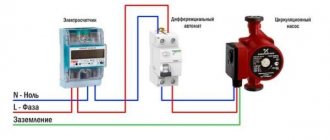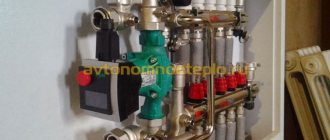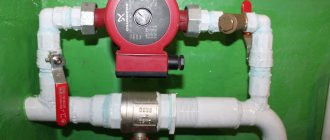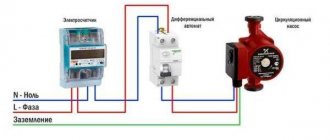Electrical diagram for connecting circulation pumps in a heating system
The wiring diagram and methods of connecting a device such as a circulation pump to electricity can have different designs. The choice of a specific option is determined by the characteristics of the heated object, as well as the location where the device is located. There are two ways to connect it:
- direct connection to a 220 V power supply;
- connection to an uninterruptible power supply, which in turn is connected to a 220 V or 220/380 V network (in the case of a three-phase UPS).
By choosing the first method, the consumer risks being left without heating in the event of a prolonged power outage. This option can be considered justified only if there is a high degree of reliability of power supply, reducing the likelihood of a long power outage to a minimum, and also if there is a backup source of electrical energy at the site. The second method is preferable, although it requires additional costs.
Connection methods
Electrical connection using a plug and socket
. This method involves installing an electrical outlet in close proximity to the place where the circulation pump is mounted. Sometimes they can be supplied with a connected cable and plug included, as in the photo:
In this case, you can simply plug the device into the mains using an outlet located within reach of the cable. You just need to make sure there is a third, grounding contact in the outlet.
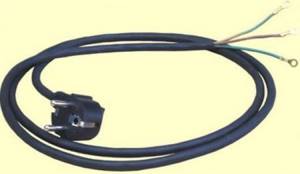
Before connecting the circulation pump, you need to find out which of the three wires of the cord is connected to the ground pin of the plug. This can be done using an ohmmeter, while at the same time checking the integrity of the remaining wires.
Open the terminal box cover. Inside the box there are three terminals designed to connect the device to the network, marked as in the picture:
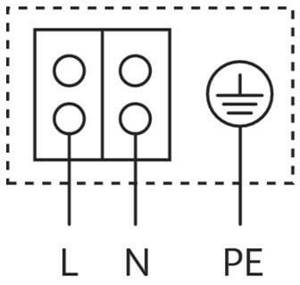
We unscrew the clamp of the cable coupling (in the first photo it is a plastic nut into which the cable is inserted), put it on our cord, and insert the cord into the coupling. If there is a cable tie inside the box, thread the cord through it. We connect the ends of the cord wires, previously stripped of insulation, to the terminals.
The wires connected to the plugs of the plug should be connected to the L and N terminals (don’t be afraid to mix them up, this is not critical), the wire of the grounding contact of the plug should be connected to the PE terminal (but you can’t make a mistake here). The instructions supplied with the product prohibit its operation without protective grounding. Next, tighten the clamp (if any), tighten the cable sleeve clamp tightly, and close the terminal box cover. The pump is ready to be plugged into the mains.
Fixed connection.
The connection diagram for the circulation pump to the electrical network with grounding is provided below:
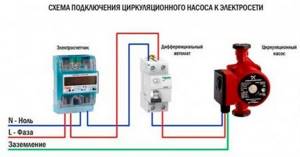
The requirements for the wire cross-section here are the same as in the previous version. The cable for this installation can be used either flexible or inflexible, copper, VVG brand, or aluminum, AVVG. If the cable is inflexible, the installation should ensure that it does not move. To do this, the cable along the entire route is secured with clamps.
In this option, a residual current device (differential circuit breaker) is used. Instead, you can use a regular single-pole circuit breaker, passing only the phase wire through it. If the machine is installed in a panel where there is a PE bus, then the cable from the pump to the machine must be three-core. If there is no such bus, the PE terminal should be connected to a grounding device. This connection can be made with a separate wire.
Separately, I would like to consider such an installation option as connecting the pump to the UPS. It is the most preferable and ensures the independence of the heating system from power outages. The connection diagram of the circulation pump to the uninterruptible power supply is provided below:
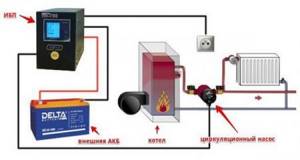
The power of the UPS should be selected based on the power of the pump motor. The capacity of the battery is determined by the estimated time of autonomous power supply of the circulation pump, that is, the time when the power supply is turned off. We talked about how to choose a UPS for a boiler in a separate article. Requirements for cable cross-section, as well as the presence of protective grounding, apply to all connection options.
Finally, we recommend watching video instructions for connecting various pump models to the electrical network:
So we looked at how to properly connect the circulation pump to the electrical network. The diagram and video examples helped to consolidate the material and clearly see the nuances of installation!
It will be useful to read:
Source
Preparing to connect the circulation pump to the heating system
The process of connecting the circulation pump to the heating system consists of several stages.
Photo 1. Circulation pump connected to the heating system. The device must be in an accessible location.
Selecting a location
The installation location is selected based on the following considerations:
- Convenient access to the central heating unit and its piping must be provided.
- The device is located after the expansion tank in the direction of movement of the coolant.
- There should be no sources of leakage above the device.
Features of placement on the return line:
- the pump with piping is installed up to the boiler shut-off valve;
- the passage of coolant through the boiler is improved;
- the likelihood of cavitation is reduced due to the pressure of the water column from the system;
- It is necessary to install a sump tank in front of the pumping device.
Features of placement on the feed:
- a pumping device with piping is installed after the safety group and the shut-off valve of the boiler;
- The operating temperature of the device must correspond to the temperature of the coolant at the installation site.
Draining the coolant
Before installation, it is necessary to drain the coolant from the system in the following sequence:
- Turn off the boiler.
- Connect one end of the hose to the tap for draining the system (the lowest one on the return line) or to a special tap on the boiler.
- Choose a place where the coolant will flow (into a special container, onto the street, into a sewer shaft). Place the second end of the hose in this place below the level of the tap to which the first end of the hose is connected.
- Open the drain tap.
- Inject air into the closed heating system (open the air vent at the highest point).
- Wait until the coolant drains completely from the tap.
- Close the tap and disconnect the hose.
Installation of additional equipment and its connection
Typically, closed or open radiator systems with one boiler are equipped with one circulation pump. More complex schemes require additional water pumping devices.
We are talking about such cases:
- A private house is heated by more than one boiler system.
- The boiler piping does not have a buffer tank.
- The heating circuit includes several branches for servicing various devices - radiators, heated floors, indirect heating boiler, etc.
- If a hydraulic separator is used.
- Water supply for heated floors is organized.
Selection (calculation) of a circulation pump
To select a circulation pump, you need to calculate its power. If you have a complex heating system, it is better to entrust the calculation of the pump to a specialist. In a simple heating system, the power of the required pump is calculated by the formula:
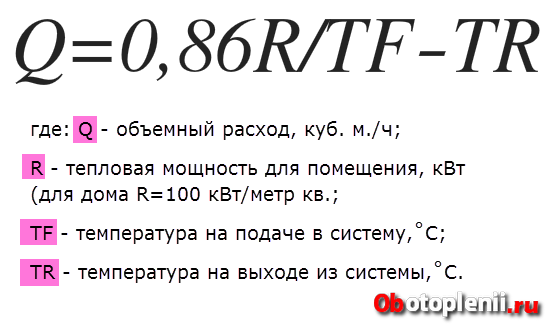
The calculation will allow you to select a pump according to the parameter: maximum water output or throughput.
Paying attention
Please note that for the circulation pump to operate, electricity must be available. The electrical power is not indicated on the pump labeling, but is 100-250 W, which allows you to connect them to any group of power outlets in the house. However, to protect against electric shock, the pump power line must be protected by a 30 mA RCD.
Important! When operating, circulation pumps produce a fairly strong “buzzing” sound. This parameter may be indicated in the pump descriptions and you need to pay attention to it; the smaller it is, the better.
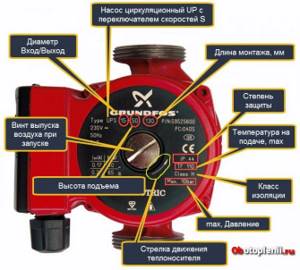
Well pump kit
Let's look at the encountered (recommended) submersible well pump kit. Typically this kit includes:
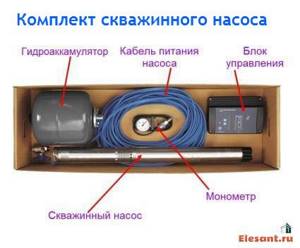
The given equipment for a well pump is the maximum and is not typical for all manufacturers of well pumps. The automation unit (control system) and hydraulic accumulator may not be included in the kit and their need is determined by the water supply scheme of the house. In the simplest version, the well pump is equipped only with an electrical cable for connection.
Understanding this, let's consider three options for connecting a well pump.
Circulation pump and elements of its piping: recommendations from experts
Choosing a circulation pump and deciding where to install it is only half the battle. It is equally important to carry out the piping correctly - only in this case can you count on long, trouble-free operation and the possibility of comfortable servicing of the unit. There is nothing complicated in the recommendations of experts:
- The pump installation location should be equipped with ball valves. With their help, it will be possible to isolate the unit from the coolant during preventive or repair measures.
- On the coolant inlet side, it is necessary to install a coarse filter, which will serve as a barrier to mechanical particles. As practice shows, the presence of such a device slows down the process of abrasive wear of the impeller several times. If we talk about the danger of damage to the pump, then the importance of filtration is difficult to overestimate.
- The uppermost point of the bypass should be equipped with a venting valve.
- The direction of movement of the coolant must coincide with the arrow on the device body.
- Since in “wet” type pumps cooling and lubrication is performed by the pumped coolant, the axis of rotation must be parallel to the horizontal.
- To ensure tightness, mating parts and their joints are sealed using gaskets and sealants.
It is equally important to correctly connect the pump to the electrical network. The type and cross-section of the cable must correspond to the power of the unit, and the connection must be made only with protective grounding.
Connection methods
Connection to the electrical network using a plug and socket . This method involves installing an electrical outlet in close proximity to the place where the circulation pump is mounted. Sometimes they can be supplied with a connected cable and plug included, as in the photo:
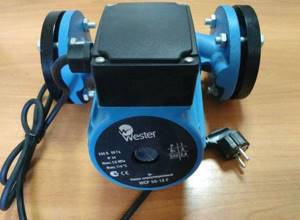
In this case, you can simply plug the device into the mains using an outlet located within reach of the cable. You just need to make sure there is a third, grounding contact in the outlet.
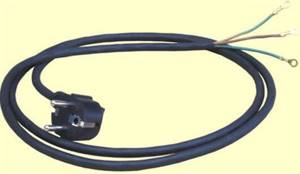
Before connecting the circulation pump, you need to find out which of the three wires of the cord is connected to the ground pin of the plug. This can be done using an ohmmeter, while at the same time checking the integrity of the remaining wires.
Open the terminal box cover. Inside the box there are three terminals designed to connect the device to the network, marked as in the picture:

We unscrew the clamp of the cable coupling (in the first photo it is a plastic nut into which the cable is inserted), put it on our cord, and insert the cord into the coupling. If there is a cable tie inside the box, thread the cord through it. We connect the ends of the cord wires, previously stripped of insulation, to the terminals.
The wires connected to the plugs of the plug should be connected to the L and N terminals (don’t be afraid to mix them up, this is not critical), the wire of the grounding contact of the plug should be connected to the PE terminal (but you can’t make a mistake here). The instructions supplied with the product prohibit its operation without protective grounding. Next, tighten the clamp (if any), tighten the cable sleeve clamp tightly, and close the terminal box cover. The pump is ready to be plugged into the mains.
Fixed connection. The connection diagram for the circulation pump to the electrical network with grounding is provided below:
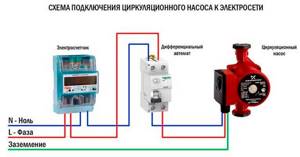
The requirements for the wire cross-section here are the same as in the previous version. The cable for this installation can be used either flexible or inflexible, copper, VVG brand, or aluminum, AVVG. If the cable is inflexible, the installation should ensure that it does not move. To do this, the cable along the entire route is secured with clamps.
In this option, a residual current device (differential circuit breaker) is used. Instead, you can use a regular single-pole circuit breaker, passing only the phase wire through it. If the machine is installed in a panel where there is a PE bus, then the cable from the pump to the machine must be three-core. If there is no such bus, the PE terminal should be connected to a grounding device. This connection can be made with a separate wire.
Separately, I would like to consider such an installation option as connecting the pump to the UPS. It is the most preferable and ensures the independence of the heating system from power outages. The connection diagram of the circulation pump to the uninterruptible power supply is provided below:
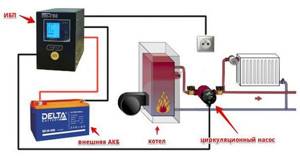
The power of the UPS should be selected based on the power of the pump motor. The capacity of the battery is determined by the estimated time of autonomous power supply of the circulation pump, that is, the time when the power supply is turned off. We talked about how to choose a UPS for a boiler in a separate article. Requirements for cable cross-section, as well as the presence of protective grounding, apply to all connection options.
Finally, we recommend watching video instructions for connecting various pump models to the electrical network:
So we looked at how to properly connect the circulation pump to the electrical network. The diagram and video examples helped to consolidate the material and clearly see the nuances of installation!
It will be useful to read:
Installation features
When wondering how to properly install a pump that will ensure efficient circulation of coolant in heating pipes, you should take into account a number of important nuances. The first of these nuances is that the rotor of the pumps must be positioned strictly horizontally when installing them. This requirement is explained by the fact that only with this arrangement of the pump with a “wet” rotor will all moving elements of its internal structure be effectively lubricated and, accordingly, will be able to avoid excessive friction and overheating.
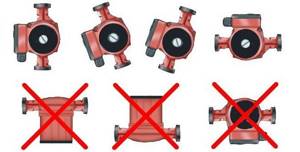
Options for correct and incorrect installation of a heating pump
The second point that should be taken into account when installing a recirculation pump for heating is the direction of coolant flow in the pipeline. There is an arrow on the body of any circulation pump that indicates in which direction the coolant should move through such a device. It is not difficult to carry out installation using this hint from the manufacturers: we look in which direction the coolant flow in the pipeline is moving, pay attention to the direction of the arrow on the pump body and install it in the correct position. It should be borne in mind that incorrect actions to install the pump on the heating circuit can lead not only to incorrect operation of such a device, but also to its rapid failure.
Selecting the right unit
When choosing a pump, pay attention to two main parameters: the strength of the coolant flow and the hydraulic resistance that it overcomes when creating pressure. In this case, the characteristics of the purchased circulation pump should be 10-15% lower than the calculated values
If you install a powerful pump in the heating system, you may encounter the problem of increasing power consumption, excessive noise, and rapid wear of equipment parts. A low-power pump will not be able to pump coolant in the required volume. Many models of modern circulation pumps are equipped with electronic or manual regulators of the speed of rotation of the electric motor shaft. The highest efficiency value is achieved at maximum shaft speed.
Thermal valves installed in many heating systems regulate the room temperature in accordance with the specified parameters. The valve closes when the temperature rises. This increases hydraulic resistance and, accordingly, increases pressure. These processes are accompanied by the appearance of noise, which can be eliminated by switching the pump to low speed. Pumps with built-in electronics that can smoothly regulate pressure drops depending on changes in the amount of water cope with this task more effectively.
How to properly install a pump in a heating system
It is mandatory to install a circulation pump in heating circuits operating on the principle of forced recirculation. The device cannot be installed in gravity systems. However, if there is a need to increase the thermal power, it is still better to install a pump.
In order for the installation of a water pump in a heating system to be effective, you need to select the right equipment for the specific wiring, as well as the type of circuit. The location of the device is selected depending on the type of boiler (gas, solid fuel, etc.).
Manufacturers now produce two types of circulation pumps for heating systems: with a dry rotor and with a wet rotor. The first option has a higher efficiency - about 80%. The disadvantages of such devices include frequent maintenance and high noise levels.
Devices with a wet rotor operate almost silently. Their efficiency is 50%; for autonomous heating of a private house, such characteristics are quite enough. However, they are demanding on the quality of the coolant. With proper operation, circulation pumps for a heating system can operate for more than 10 years.
In order for the unit to pump water to operate for a long time without breakdowns, before purchasing it, you should calculate the hydraulics of the heating circuit. Based on the results, select the device model. It is imperative to pay attention to such parameters of circulation pumps for heating systems as performance, maximum permissible operating temperature of the coolant, pressure, etc.
Installation of the device must be carried out strictly according to the manufacturer's instructions. Only correct installation of the circulation pump in the heating system will ensure stable pressure and uninterrupted operation of the equipment.
How to install a circulation pump for heating:
- Drain the water from the heating system and rinse it (long-term operating lines are rinsed several times).
- Install the device into the installed location according to the instructions. Usually for these purposes the pipeline is equipped with a bypass, depending on the type of system.
- Fill the pump with water.
- Inspect the heating circuit for leaks and other errors.
- Bleed air from the system using the central screw.
- Connect the unit to the network.
If the circulation pump is installed correctly in the heating system, then the device will be able to operate at full capacity. The pumping device allows you to increase the speed of the coolant and even organize heated floors.
The pump must be installed in the heating system after the heat generator. There are no special requirements for the installation location (return or supply pipe). The location of pumping equipment on the pipeline is selected depending on the type of wiring and the operating characteristics of the heating network. However, in systems with solid fuel boilers, it is still recommended to install such devices on the return line. In case of overheating, this will delay the moment of explosion of the heat generator by 20-30 minutes. In general, if you quickly extinguish wood or other types of fuel, you can cool the system and avoid an emergency.
Optimal pump speed
The task of a heating system with pump circulation is to reliably deliver coolant to all consumers of the system, including the furthest radiators. For this to happen effectively, the pump must create the pressure necessary for this: the designers calculate it, taking into account the hydraulic resistance of the pipes. Most often, household pumps have 3-7 rotor speeds, which allows you to increase or decrease work productivity.
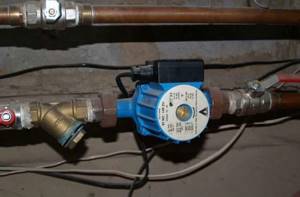
The easiest way to select the optimal speed of the circulation pump:
- The heating system must be brought into operating mode.
- Measure the pipe surface temperature before and after the boiler using a laser surface thermometer (pyrometer).
- If the temperature difference is more than 20 degrees, the rotor rotation speed must be increased.
- If the difference is less than 10 degrees, the flow rate must be reduced. The optimal difference between the supply and return heating levels is approximately 15 degrees.
The pyrometer need not be used when the supply and return pipes are equipped with thermometers. If, with the help of adjustments, it is not possible to achieve the required temperature difference of 10-20 degrees, this indicates low efficiency of the system. The cause is most often an error in the selection of the circulation apparatus. Too low a return water temperature provokes an increase in the load on the boiler and an increase in energy consumption. Very hot water circulates too quickly to transfer heat to the heaters.
For proper operation, any circulation pump requires a phase, a working zero and grounding (protective zero), respectively, the diagram for connecting the pump to the electrical network is as follows:
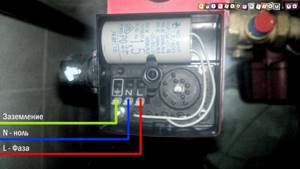
We discussed in some detail the standard connection diagram for a circulation pump, as well as the connection diagram for a pump via a thermostat and an uninterruptible power supply (UPS), in the article “Connection diagram for a circulation pump.”
There are usually two main ways to connect the pump to the electrical network:
Electrical wiring is carried out to the pump and a standard socket is installed at the end, no matter external or internal.
In this case, a cable with a plug, for example SHUCKO type or another, is connected to the pump, always with protective grounding contacts.
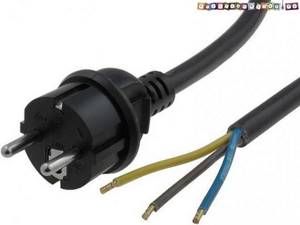
Then the plug is plugged into the socket and thereby provides power to the circulation pump.
2. Connect directly
Electrical wiring is carried out to the installation site of the circulation pump and the connection is made using the same cable, without any unnecessary connections.
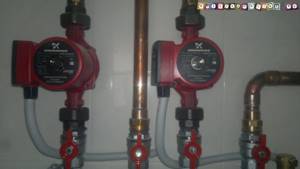
Each of these methods has its own disadvantages and advantages, and one of them is chosen depending on the specific circumstances. As an example of installation, the option of connecting the circulation pump to the electrical network directly will be used.
1. GRUNDFOS UPS 25-40 circulation pump installed in the heating system of the house

2. Concealed electrical wiring to the pump was made according to the following scheme:

The power cable, in a protective PVC corrugation, comes out of the wall at the connection point.
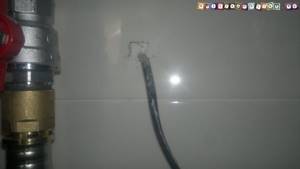
The main advantages of using heating pumps
For a long time, pressure blowers were cumbersome and were used only in industrial enterprises and central heating boiler houses. In private houses, the natural movement of the coolant was designed - due to the slope of the pipes and the temperature difference in them.
With the reduction in size and cost, connecting a circulation pump to the heating system has become almost mandatory, although this device is not the main equipment.
Installing circulation equipment in the heating system of a private house increases its performance and the comfort of residents:
Provides fast and uniform heating of the room due to the higher flow rate in the batteries; You can use pipes of 2 times smaller diameter without reducing the throughput; A highway with a minimal slope looks more aesthetically pleasing; A correctly selected pump installation scheme will ensure uniform heating of heating devices of various types, from radiators to heated floors, as well as long circuits; It becomes possible to hide distribution pipes in the cladding of walls, floors or ceilings; The boiler works more efficiently and economically.
The main disadvantage of forced circulation systems is their energy dependence. It can be leveled through a UPS or a gas power generator. The same purpose is served by connecting a pump to a mixed-type heating system, which operates with both forced and natural circulation.
When choosing a supercharger, the most important characteristic is maximum performance. To calculate how to make a heating pump efficient without overpaying, multiply the thermal power (100 kW per 1 sq. m.) by a factor of 0.86.
Divide the resulting number by the temperature difference between the supply and return pipes. The resulting number is the throughput per hour.
Heating system pump connection diagram
Disputes continue over which place is better to connect the pump to the heating system: in the supply or return line.

The connection diagram for the heating system pump in the return line is protected with the following arguments:
equipment will operate longer in a lower temperature environment. In fact, the circuit of the heating water pump and the materials in it can withstand temperatures of up to 110 - 115 degrees, which is significantly higher than the temperature of the coolant; cooled water has a higher density and is pushed through the impeller more easily. In fact, the difference in density is about 1%, 10 kg/cubic. m., does not matter; The return pipe is lower, so the static pressure is higher, which helps the pump work. But the height difference of 0.5 - 1.5 m is also negligible; This heating pump connection diagram is used in industrial boiler houses. There it is justified due to the convenience of placing large and heavy equipment below.
Heating registers made of profile pipe
I present a homemade clamp (fix) from a 20x40 mm pipe. I couldn’t find anything like this on the Internet, so I decided to show it. Although maybe a button accordion).
Clamp made of profile pipe.
In 5 minutes I will try to tell you how the stove is made, how it works, and what little nuances there are. DIY crafts at home.
You can make heating in your home yourself quite easily, given the variety of materials and technologies currently used.
Harness
There are two types of heating systems - forced and natural circulation. Systems with forced circulation cannot work without a pump; systems with natural circulation work, but in this mode they have lower heat transfer. However, less heat is still much better than no heat at all, so in areas where electricity is often cut off, the system is designed as hydraulic (with natural circulation), and then a pump is installed into it. This gives high heating efficiency and reliability. It is clear that the installation of a circulation pump in these systems is different.

All heating systems with heated floors are forced - without a pump, the coolant will not pass through such large circuits
Forced circulation
Since a forced circulation heating system without a pump is inoperative, it is installed directly into the gap in the supply or return pipe (of your choice).
Most problems with the circulation pump arise due to the presence of mechanical impurities (sand, other abrasive particles) in the coolant. They can jam the impeller and stop the motor. Therefore, a mesh dirt filter must be placed in front of the unit.
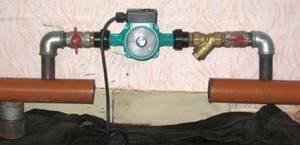
Installing a circulation pump in a forced circulation system
It is also advisable to install ball valves on both sides. They will make it possible to replace or repair the device without draining the coolant from the system. Turn off the taps and remove the unit. Only that part of the water that was directly in this piece of the system is drained.
Natural circulation
The piping of the circulation pump in gravity systems has one significant difference - a bypass is required. This is a jumper that makes the system operational when the pump is not working. One ball shut-off valve is installed on the bypass, which is closed the entire time the pumping is running. In this mode, the system operates as forced.
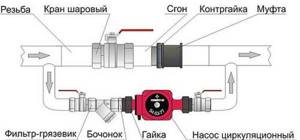
Installation diagram of a circulation pump in a system with natural circulation
When the electricity goes out or the unit fails, the valve on the jumper is opened, the valve leading to the pump is closed, and the system operates as a gravity system.
Installation features
There is one important point, without which the installation of the circulation pump will require rework: it is necessary to rotate the rotor so that it is directed horizontally. The second point is the direction of flow. There is an arrow on the body indicating which direction the coolant should flow. This is how you turn the unit so that the direction of movement of the coolant is “in the direction of the arrow”.
The pump itself can be installed both horizontally and vertically, just when selecting a model, make sure that it can work in both positions. And one more thing: with a vertical arrangement, the power (pressure created) drops by about 30%. This must be taken into account when choosing a model.
Criterias of choice
The first important indicator when choosing a pump is its power. For high-quality heating, you should select a device with exactly the power that will be sufficient for heating. More expensive and powerful pumps are not needed for an ordinary residential building - they still will not turn on at full load.

To calculate the optimal power, the following parameters should be taken into account: coolant temperature at the inlet and outlet, pressure, throughput, and productivity of the heating boiler. The coolant consumption can be equated to the boiler power
For example, a heating unit with a power of 30 kW moves 30 liters of coolant in 1 minute
The coolant consumption can be equated to the boiler power. For example, a heating unit with a power of 30 kW moves 30 liters of coolant in 1 minute.
The simplest formula for calculating the optimal pump power looks like this: Q = N/(T2 – T1), in this formula N is the boiler power, and T2 and T1 are the difference in water temperatures at the outlet of the tank and in the return.
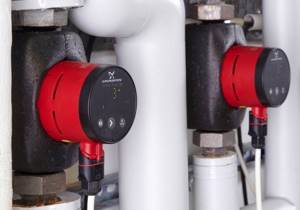
The pressure is calculated based on the square footage of the heated area. According to generally accepted standards, a pump power of about 100 W is required per 100 m2 of a residential building.
Installation of the circulation pump is carried out as follows. First you need to carefully study the instructions and the diagram according to which it should be connected. The boiler and all heating equipment require regular inspection and maintenance, so you need to prepare an approach to the main components of the devices in advance. Then you need to drain all the coolant and clean the pipeline, after which you can decide on the installation location.
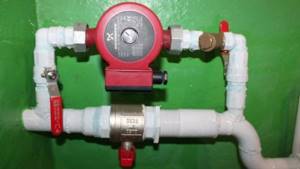
So, experts recommend installing this equipment near the boiler, on the return pipe. This position is explained by two reasons: a pump installed in this place will allow the coolant to be distributed more evenly in the boiler, and therefore increase the efficiency of the entire heating system. In addition, on the return side the circulation pump will operate at a lower operating temperature, which will increase its service life.
Bypass installation
A bypass (bypass) is performed in the sector selected for installation. This operation is necessary to ensure that the system continues to circulate even if the power supply is turned off or the pumping equipment breaks down.

The diameter of the bypass system pipe must be less than the diameter of the main gas pipeline pipes. Only after installing the bypass do they begin to install the unit.
A drawing with the technology for installing a circulation pump is presented in this diagram:
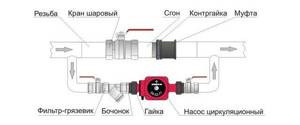
Installation Features
It must be remembered that the shaft must be positioned horizontally. If installed incorrectly, the circulation pump loses up to 30% of its performance and may fail within a short time. The terminal box must be installed at the top of the system.
Ball valves must be installed on both sides of the unit - they will definitely be needed in the future, during regular technical inspections and scheduled repair work.
The heating system must also have filters to purify the water in the pipelines from various solid particles. The latter, if they get into pumping equipment, lead to serious damage to it.

A valve is installed on top of the bypass pipe to bleed air from the heating system. When installing the motor shaft, it is necessary to provide for the rotation of the box along the axis with a slight force. An expansion tank must be installed in an open heating system.
Mechanical repair
All other parts that are not listed in the section: “Electrical repair” refer to mechanical components. If vibration or noise occurs in a running pump, to determine the source of its occurrence it is necessary:
- Stop the boiler smoothly.
- Remove the front panel of the housing and lower the control unit.
- Close the cold water, supply and return taps.
- Drain water from the boiler system through the drain valve.
- Unscrew the pump air vent lock to completely drain the water from the system. After all the fluid has been drained, tighten the lock until it stops.
- Remove the terminal with the starting capacitor.
- Unscrew the fastening screws and remove the motor-turbine unit.
- Inspect the bearings, impeller, and pump cavity for oxidation, contamination, foreign objects, and damage. If there is wear on the bearings or the motor shaft rotates with force, then they need to be replaced with others, for example, fluoroplastic ones. All dirt from the turbine, internal compartments of the housing, and sealing rubber should be removed.
- Place the repaired mechanism in place and secure it.
- Insert the terminal with the capacitor.
- Open the return, supply and cold water taps.
- Using the make-up tap, check the pump for leaks; if it does not leak, then add coolant to the system up to 1.2 bar.
- Start the pump in circulation mode and check its condition.
- If the results are positive, set the heating circuit temperature control knob to the required position.
The service life of the Wilo circulation pump and other boiler components can be extended if full maintenance is carried out before each heating season.
Automation for Grundfos submersible pump
Electronic control units automatically control pumping equipment without human intervention. The equipment monitors many system parameters: pressure force, network voltage and operating temperature of the drive winding.
Grundfos presents a wide range of electronic equipment.
This allows you to select equipment for any operating conditions:
Advantages of the Grunfos well pump.
Automation units can be installed on any pumping mechanisms, thereby turning the devices into full-fledged pumping stations.



